ISSN ONLINE(2319-8753)PRINT(2347-6710)
ISSN ONLINE(2319-8753)PRINT(2347-6710)
| V.S.Shaisundaram, S.Yogaraj, D. Sakthimurugan Assistant Professor, Department of Mechanical Engineering, Easwari Engineering College, Chennai, India |
| Related article at Pubmed, Scholar Google |
Visit for more related articles at International Journal of Innovative Research in Science, Engineering and Technology
The depletion of fossil fuel resources on a worldwide basis has necessitated an urgent search for alternative energy sources to meet up the present day demands. Solar energy is clean, inexhaustible and environmentfriendly potential resource among renewable energy options. But neither a standalone solar photovoltaic system nor a wind energy system can provide a continuous supply of energy due to seasonal and periodic variations. Therefore, in order to satisfy the load demand, grid connected energy systems are now being implemented that combine solar and conventional conversion units. Solar photovoltaic option for meeting power demand at Pondicherry engineering college is fully theoretical based project. The main objective of this project are Meteorological data for the site ,Load forecasting at Pondicherry engineering college, Component selection ,Design layout of solar photovoltaic plant ,Testing and analysis of system design by using PVSYST software .Finally obtained electricity consumption by load forecasting technique can be validated by using PVSYST software
Keywords |
| grid connected, solar photovoltaic system, Meteorological data for the site, load forecasting, design layout, testing and analysis using PVSYST software |
INTRODUCTION |
| Energy plays a pivotal role in our daily activities. The degree of development and civilization of a country is measured by the amount of utilization of energy by human beings. Energy demand is increasing day by day due to increase in population, urbanization and industrialization. The world’s fossil fuel viz., coal, petroleum and natural gas will thus deplete in few hundred years. The rate of energy consumption increasing, supply is depleting resulting in inflation and energy shortage. This is called energy crisis. Hence alternative or renewable sources of energy have to be developed to meet future energy requirement. |
1.2 WE PREFER GRID CONNECTED PV SYSTEM |
| Because as day by day the demand of electricity is increased and that much demand cannot be meeting up by the conventional power plants. And also these plants create pollution. So if we go for the renewable energy it will be better but throughout the year the generation of all renewable energy power plants. Grid tied PV system is more reliable than other PV system. No use of battery reduces its capital cost so we go for the grid connected topology. If generated solar energy is integrated to the conventional grid, it can supply the demand from morning to afternoon (total 6 hours mainly in sunny days) that is the particular time range when the SPV system can fed to grid. As no battery backup is there, that means the utility will continue supply to the rest of the time period. Grid-connected systems have demonstrated an advantage in natural disasters by providing emergency power capabilities when utility power was interrupted. Although PV power is generally more expensive than utility-provided power, the use of grid connected systems is increasing. |
II. METHODOLOGY OF THIS PROJECT |
| The methodologies of the projects are as follows ïÃÆÃË Meteorological Data for the site ïÃÆÃË Load calculation at Pondicherry engineering college ïÃÆÃË Selection of components System sizing and specification |
| ïÃÆÃË Design layout of solar photovoltaic plant ïÃÆÃË Testing and analysis of system design by using pvsyst software 2.1 METEOROLOGICAL DATA FOR PONDICHERRY ENGINEERING COLLEGE Meteorological data includes solar radiation, sunshine hours, temperature of air and wind velocity for the sites. Pondicherry engineering college campus is situated at Pillaichavady which is about 12 km from the railway station and bus-stand in Pondicherry town. It is about 160 km south of Chennai (Madras) on the shores of Bay of Bengal and spread over 240 acres (0.9712 sq.KM). Located at latitude of 12°00′47.74″N and longitude of 79°51′13.78″E. This activity shall assess solar resource attractiveness of the proposed site. This shall include assessment of parameters like Global Horizontal Solar Radiation, Diffused Horizontal Solar Radiation, Direct Normal Solar Radiation, Wind Speed/Direction and Air Temperature. To estimate the meteorological data for the site by using METEONORM software. |
III. METEONORM SOFTWARE |
| Meteonorm is a comprehensive meteorological reference. It gives you access to meteorological data for solar applications, system design and a wide range of other applications for any location in the world. The sophisticated interpolation models inside meteonorm allow a reliable calculation of solar radiation, temperature and additional parameters at any site in the world. By using Meteonorm software to predict the global solar radiation, diffuse solar radiation, beam radiation, ambient temperature and wind velocity at Pondicherry engineering college based on these years from 2000-2009. |
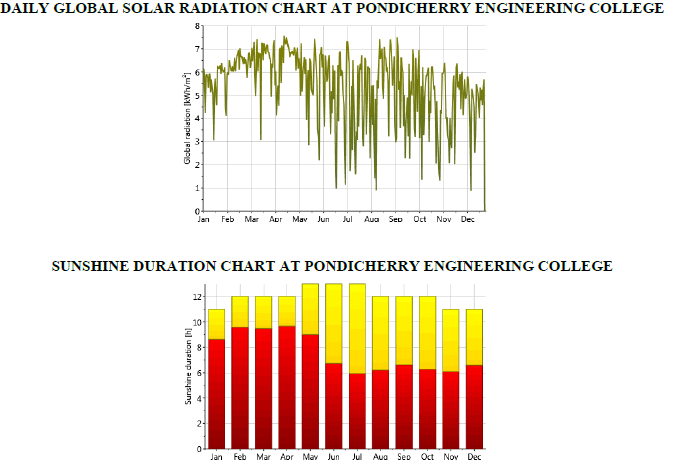 |
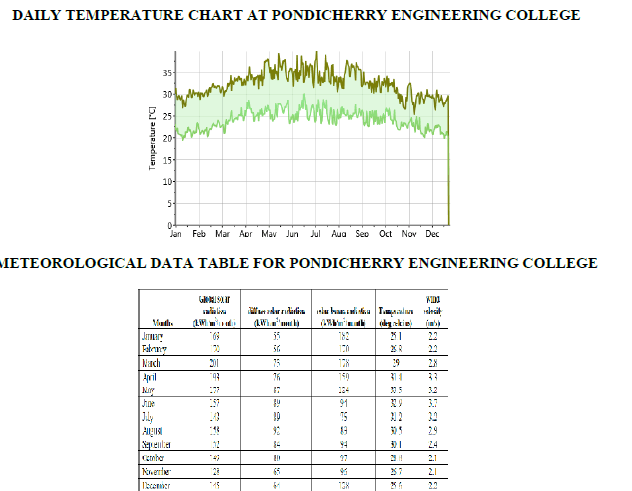 |
| From the meteorological data the average global radiation per day is 5.32 kWh/m2, average temperature 29.3deg.celcius and average wind velocity is 2.69m/s. Thus the Pondicherry engineering college is suitable for installing solar photovoltaic system. 2.2 LOAD CALCULATION AT PONDICHERRY ENGINEERING COLLEGE In this project, load calculation can be done by using forecasting technique.Forecasting is the establishment of future expectations by the analysis of past data, or the formation of opinions. Load forecasting can be done based on the past years electricity consumed at Pondicherry engineering college. |
ELECTRICITY CONSUMPTION GRAPH FOR PONDICHERRY ENGINEERING COLLEGE (2009) |
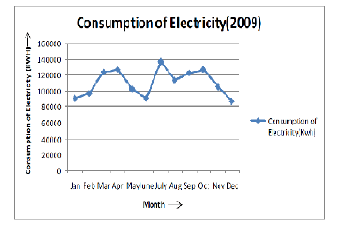 |
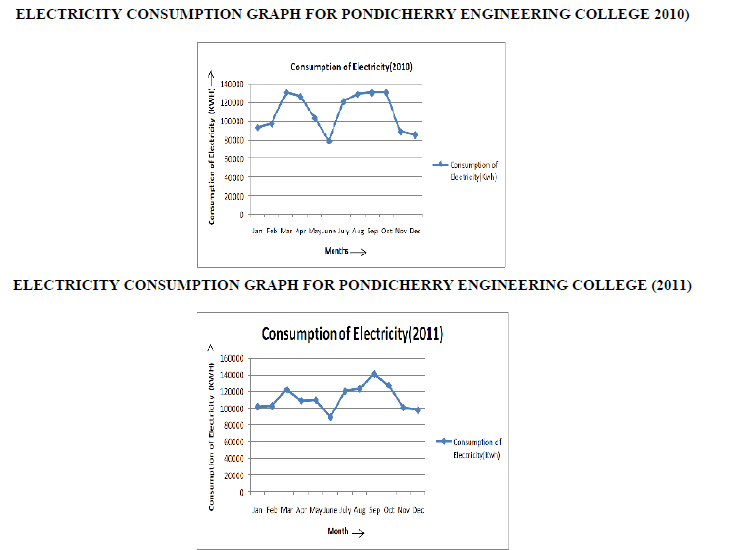 |
IV. LOAD FORECASTING |
| Regression forecasting technique In regression forecasting technique, by considering last three years electricity consumption at Pondicherry engineering college. We can predict the electricity consumption in year 2020. In this forecasting technique Formula for finding electricity consumption is Y=A+Bx Where Y= electricity consumption X= years A= (ΣY) /n B= (Σ XY) / (ΣX2) Based on the consumption of electricity in last three years (2009, 2010, and 2011). We get the equation Y=1280021+10435(X) By substituting x values, we get electricity consumption graph in the year of 2020. |
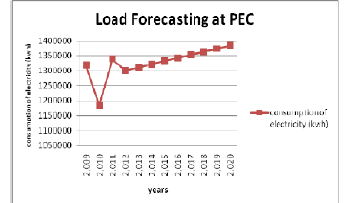 |
| From the load forecasting graph , we predict the electricity consumption in 2020 is 1384371 kWh. Therefore average electricity consumption per day is 160kW. While design a solar photovoltaic system, choosing a maximum electricity consumption data.hence solar phovoltaic system can be design in rated of 250 kW. |
V.SELECTION OF COMPONENTS |
| The basic Grid Connected PV system design has the following components: |
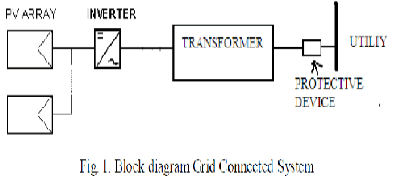 |
| P V ARRAY: A number of PV panels connected in series and/or in parallel giving a DC output out of the incident irradiance. Orientation and tilt of these panels are important design parameters, as well as shading from surrounding obstructions. |
| INVERTER: A power converter that 'inverts' the DC power from the panels into AC power. The characteristics of the output signal should match the voltage, frequency and power quality limits in the supply network. |
| T R A N S F O R M E R : A transformer can boost up the ac output voltage fro m inverter when needed. Otherwise transformer less design is also acceptable. |
| LOAD: Stands for the network connected appliances that are fed from the inverter, or, alternatively, from the grid. |
| METERS : They account for the energy being drawn from or fed into the local supply network. |
| P R O T E C T I V E DEVICES: Some protective devices is also installed, like under voltage relay, circuit breakers etc for resisting power flow from utility to SPV system. |
| O T H E R DEVICES: Other devices like dc-dc boost converter, ac filter can also be used for better performance. |
VI. DESIGN LAYOUT OF SOLAR PHOTOVOLTAIC GRID CONNECTED SYSTEM |
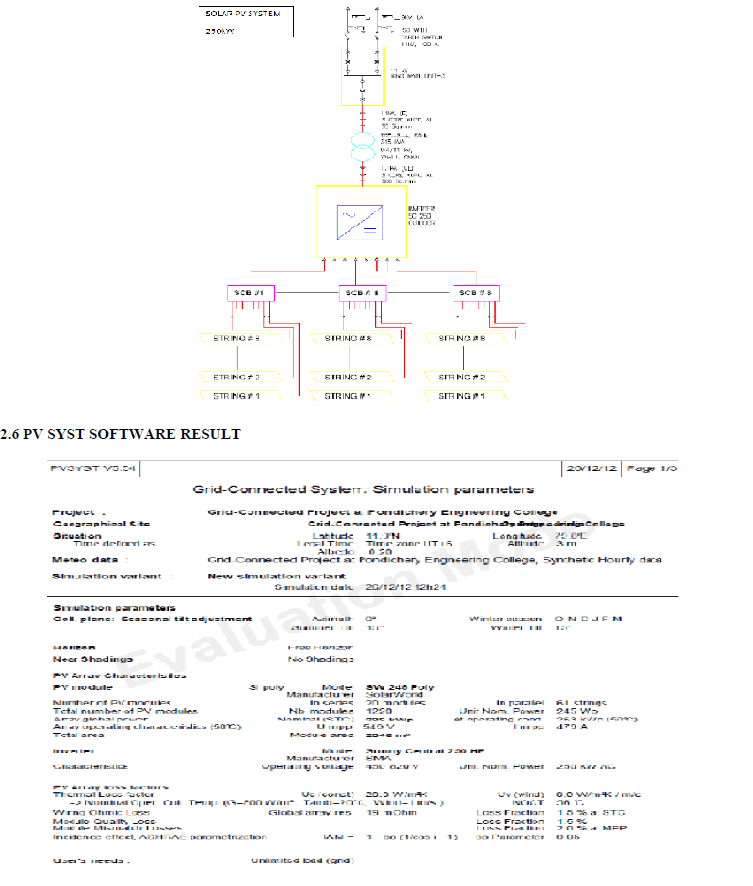 |
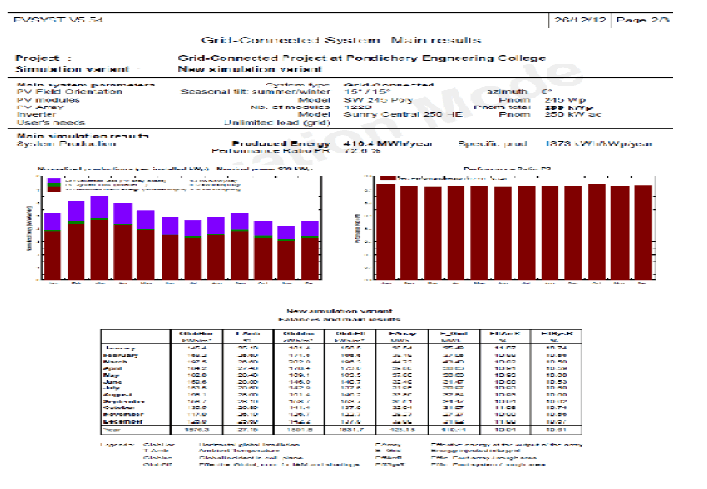 |
VII. RESULTS AND CONCLUSION |
| As per energy forecasting technique, average electricity consumption per month in Pondicherry engineering college is 115364kWh.Obtained electricity consumption by solar photovoltaic grid connected system based on pv syst software is 142361kWh per month. Thus solar photovoltaic design can be validated. |
References |
|